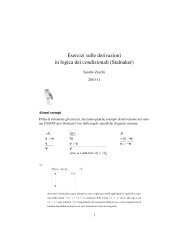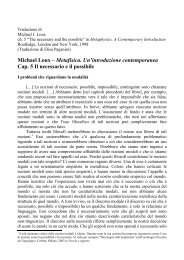Some Remarks on Logical Form
Some Remarks on Logical Form
Some Remarks on Logical Form
Create successful ePaper yourself
Turn your PDF publications into a flip-book with our unique Google optimized e-Paper software.
<str<strong>on</strong>g>Some</str<strong>on</strong>g> <str<strong>on</strong>g>Remarks</str<strong>on</strong>g> <strong>on</strong> <strong>Logical</strong> <strong>Form</strong><br />
Author(s): L. Wittgenstein<br />
Source: Proceedings of the Aristotelian Society, Supplementary Volumes, Vol. 9, Knowledge,<br />
Experience and Realism (1929), pp. 162-171<br />
Published by: Blackwell Publishing <strong>on</strong> behalf of The Aristotelian Society<br />
Stable URL: http://www.jstor.org/stable/4106481<br />
Accessed: 06/12/2009 14:06<br />
Your use of the JSTOR archive indicates your acceptance of JSTOR's Terms and C<strong>on</strong>diti<strong>on</strong>s of Use, available at<br />
http://www.jstor.org/page/info/about/policies/terms.jsp. JSTOR's Terms and C<strong>on</strong>diti<strong>on</strong>s of Use provides, in part, that unless<br />
you have obtained prior permissi<strong>on</strong>, you may not download an entire issue of a journal or multiple copies of articles, and you<br />
may use c<strong>on</strong>tent in the JSTOR archive <strong>on</strong>ly for your pers<strong>on</strong>al, n<strong>on</strong>-commercial use.<br />
Please c<strong>on</strong>tact the publisher regarding any further use of this work. Publisher c<strong>on</strong>tact informati<strong>on</strong> may be obtained at<br />
http://www.jstor.org/acti<strong>on</strong>/showPublisherpublisherCode=black.<br />
Each copy of any part of a JSTOR transmissi<strong>on</strong> must c<strong>on</strong>tain the same copyright notice that appears <strong>on</strong> the screen or printed<br />
page of such transmissi<strong>on</strong>.<br />
JSTOR is a not-for-profit service that helps scholars, researchers, and students discover, use, and build up<strong>on</strong> a wide range of<br />
c<strong>on</strong>tent in a trusted digital archive. We use informati<strong>on</strong> technology and tools to increase productivity and facilitate new forms<br />
of scholarship. For more informati<strong>on</strong> about JSTOR, please c<strong>on</strong>tact support@jstor.org.<br />
The Aristotelian Society and Blackwell Publishing are collaborating with JSTOR to digitize, preserve and<br />
extend access to Proceedings of the Aristotelian Society, Supplementary Volumes.<br />
http://www.jstor.org
SOME REMARKS ON LOGICAL FORM.<br />
By L. WITTGENSTEIN.<br />
Every propositi<strong>on</strong> has a c<strong>on</strong>tent and a form. We get<br />
the picture of the pure form if we abstract from the meaning<br />
of the single words, or symbols (so far as they have<br />
independent meanings). That is to say, if we substitute<br />
variables for the c<strong>on</strong>stants of the propositi<strong>on</strong>. The rules of<br />
syntax which applied to the c<strong>on</strong>stants must apply to the<br />
variables also. By syntax in this general sense of the word<br />
I mean the rules which tell us in which c<strong>on</strong>necti<strong>on</strong>s <strong>on</strong>ly<br />
a word gives sense, thus excluding n<strong>on</strong>sensical structures.<br />
The syntax of ordinary language, as is well known, is not<br />
quite adequate for this purpose. It does not in all cases<br />
prevent the c<strong>on</strong>structi<strong>on</strong> of n<strong>on</strong>sensical pseudopropositi<strong>on</strong>s<br />
(c<strong>on</strong>structi<strong>on</strong>s such as " red is higher than green " or " the<br />
Real, though it is an in itself, must also be able to become<br />
a for myself ", etc.).<br />
If we try to analyze any given propositi<strong>on</strong>s we shall find<br />
in general that they are logical sums, products or other<br />
truthfuncti<strong>on</strong>s of simpler propositi<strong>on</strong>s. But our analysis,<br />
if carried far enough, must come to the point<br />
where it reaches propositi<strong>on</strong>al forms which are not themselves<br />
composed of simpler propositi<strong>on</strong>al forms. We must<br />
eventually reach the ultimate c<strong>on</strong>necti<strong>on</strong> of the terms, the<br />
immediate c<strong>on</strong>necti<strong>on</strong> which cannot be broken without
LOGICAL FORM. 183<br />
destroying the propositi<strong>on</strong>al form as such. The propositi<strong>on</strong>s<br />
which represent this ultimate c<strong>on</strong>nexi<strong>on</strong> of terms<br />
I call, after B. Russell, atomic propositi<strong>on</strong>s. They, then, are<br />
the kernels of every propositi<strong>on</strong>, they c<strong>on</strong>tain the material,<br />
and all the rest is <strong>on</strong>ly a development of this material.<br />
It is to them we have to look for the subject matter of propositi<strong>on</strong>s.<br />
It is the task of the theory of knowledge to find<br />
them and to understand their c<strong>on</strong>structi<strong>on</strong> out of the words<br />
or symbols. This task is very difficult, and Philosophy<br />
has hardly yet begun to tackle it at some points. What<br />
method have we for tackling it The idea is to express in<br />
an appropriate symbolism what in ordinary language leads<br />
to endless misunderstandings. That is to say, where<br />
ordinary language disguises logical structure, where it<br />
allows the formati<strong>on</strong> of pseudopropositi<strong>on</strong>s, where it<br />
uses <strong>on</strong>e term in an infinity of different meanings, we must<br />
replace it by a symbolism which gives a clear picture of<br />
the logical structure, excludes pseudopropositi<strong>on</strong>s, and uses<br />
its terms unambiguously. Now we can <strong>on</strong>ly substitute a<br />
clear symbolism for the unprecise <strong>on</strong>e by inspecting the<br />
phenomena which we want to describe, thus trying to<br />
understand their logical multiplicity. That is to say, we<br />
can <strong>on</strong>ly arrive at a correct analysis by,what might be called,<br />
the logical investigati<strong>on</strong> of the phenomena themselves, i.e.,<br />
in a certain sense a posteriori, and not by c<strong>on</strong>jecturing<br />
about a priori possibilities. One is often tempted to ask<br />
from an a priori standpoint: What, after all, can be the<br />
<strong>on</strong>ly forms of atomic propositi<strong>on</strong>s, and to answer, e.g.,<br />
subject-predicate and relati<strong>on</strong>al propositi<strong>on</strong>s with two or<br />
more terms further, perhaps, propositi<strong>on</strong>s relating predicates<br />
and relati<strong>on</strong>s to <strong>on</strong>e another, and so <strong>on</strong>. But this, I believe,<br />
is mere playing with words. An atomic form cauuot be<br />
foreseen. And it would be surprising if the actual<br />
It 2
164 F. WITTGENSTEIN.<br />
phenomena had nothing more to teach us about their<br />
structure. To such c<strong>on</strong>jectures about the structure of<br />
atomic propositi<strong>on</strong>s, we are led by our ordinary language,<br />
which uses the subject-predicate and the relati<strong>on</strong>al form.<br />
But in this our language is misleading: I will try to explain<br />
this by a simile. Let us imagine two parallel planes,<br />
I and II. On plane I figures are drawn, say, ellipses and<br />
rectangles of different sizes and shapes, and it is our task<br />
to produce images of these figures <strong>on</strong> plane II.<br />
Then we can imagine two ways, am<strong>on</strong>gst others, of doing<br />
this. We can, first, lay down a law of projecti<strong>on</strong>say<br />
that of orthog<strong>on</strong>al projecti<strong>on</strong> or any other-and then<br />
proceed to project all figures from I into II, according to<br />
this law. Or, sec<strong>on</strong>dly, we could proceed thus: We lay<br />
down the rule that every ellipse <strong>on</strong> plane I is to appear as<br />
a circle in plane II, and every rectangle as a square in II.<br />
Such a way of representati<strong>on</strong> may be c<strong>on</strong>venient for us if for<br />
some reas<strong>on</strong> we prefer to draw <strong>on</strong>ly circles and squares<br />
<strong>on</strong> plane II. Of course, from these images the exact shapes<br />
of the original figures <strong>on</strong> plane I cannot be immediately<br />
inferred. We can <strong>on</strong>ly gather from them that the original<br />
was an ellipse or a rectangle. In order to get in a single<br />
instance at the determinate shape of the original we would<br />
have to know the individual method by which, e.g.,<br />
a particular ellipse is projected into the circle before me.<br />
The case of ordinary language is quite analogous. If the<br />
facts of reality are the ellipses and rectangles <strong>on</strong> plane I<br />
the subject-predicate and relati<strong>on</strong>al forms corresp<strong>on</strong>d to<br />
the circles and squares in plane II. These forms are the<br />
norms of our particular language into which we project in<br />
ever so many different ways ever so many different logical<br />
forms. And for this very reas<strong>on</strong> we can draw no c<strong>on</strong>clusi<strong>on</strong>s-except<br />
very vague <strong>on</strong>es-from the use of these
LOGICAL FORM. 165<br />
norms as to the actual logical form of the phenomena de-<br />
scribed. Such forms as " This paper is boring ", " The<br />
weather is fine ", " I am lazy ", which have nothing what-<br />
ever in comm<strong>on</strong> with <strong>on</strong>e another, present themselves as<br />
subject-predicate propositi<strong>on</strong>s, i.e., apparently as propositi<strong>on</strong>s<br />
of the same form.<br />
If, now, we try to get at an actual analysis, we find<br />
logical forms which have very little similarity with the<br />
norms of ordinary language. We meet with the forms of<br />
space and time with the whole manifold of spacial and<br />
temporal objects, as colours, sounds, etc., etc., with their<br />
gradati<strong>on</strong>s, c<strong>on</strong>tinuous transiti<strong>on</strong>s, and combinati<strong>on</strong>s in<br />
various proporti<strong>on</strong>s, all of which we cannot seize by<br />
our ordinary means of expressi<strong>on</strong>. And here I wish to<br />
make my first definite remark <strong>on</strong> the logical analysis of<br />
actual phenomena: it is this, that for their representati<strong>on</strong><br />
numbers (rati<strong>on</strong>al and irrati<strong>on</strong>al) must enter into the structure<br />
of the atomic propositi<strong>on</strong>s themselves. I will illustrate<br />
this by an example. Imagine a system of rectangular<br />
axes, as it were, cross wires, drawn in our field of visi<strong>on</strong><br />
and an arbitrary scale fixed. It is clear that we then can<br />
describe the shape and positi<strong>on</strong> of every patch of colour in<br />
our visual field by means of statements of numbers which<br />
have their significance relative to the system of co-ordinates<br />
and the unit chosen. Again, it is clear that this<br />
descripti<strong>on</strong> will have the right logical multiplicity, and that<br />
a descripti<strong>on</strong> which has a smaller multiplicity will not do.<br />
A simple example would be the representati<strong>on</strong> of a patch<br />
P by the expressi<strong>on</strong> " [6-9, 3---8] " and of a propositi<strong>on</strong>
166 F. WITTGENSTEIN.<br />
10-<br />
9-<br />
8-<br />
7-<br />
6-<br />
5-----<br />
4-<br />
3-<br />
2-<br />
1-<br />
I 1<br />
l l dIl I I I<br />
about it, e.g., P is red, by the symbol " [6-9, 3--8] R ",<br />
where " R " is yet an unanalyzed term (" 6--9 " and<br />
" " 3-8- stand for the c<strong>on</strong>tinuous interval between the respective<br />
numbers). The system of co-ordinates here is part<br />
of the mode of expressi<strong>on</strong>; it is part of the method of projecti<strong>on</strong><br />
by which the reality is projected into our symbolism.<br />
The relati<strong>on</strong> of a patch lying between two others can be expressed<br />
analogously by the use of apparent variables. I<br />
need not say that this analysis does not in any way pretend<br />
to be complete. I have made no menti<strong>on</strong> in it of time,<br />
and the use of two-dimensi<strong>on</strong>al space is not justified even<br />
in the case of m<strong>on</strong>ocular visi<strong>on</strong>. I <strong>on</strong>ly wish to point out<br />
the directi<strong>on</strong> in which, I believe, the analysis of visual<br />
phenomena is to be looked for, and that in this analysis<br />
we meet with logical forms quite different from those which<br />
ordinary language leads us to expect. The occurrence of<br />
numbers in the forms of atomic propositi<strong>on</strong>s is, in my<br />
opini<strong>on</strong>, not merely a feature of a special symbolism, but<br />
an essential and, c<strong>on</strong>sequently, unavoidable feature of the<br />
representati<strong>on</strong>. And numbers will have to enter these forms<br />
when-as we should say in ordinary language-we are
LOGICAL FORM. 167<br />
dealing with properties which admit of gradati<strong>on</strong>, i.e., properties<br />
as the length of an interval, the pitch of a t<strong>on</strong>e,<br />
the brightness or redness of a shade of colour, etc. It is<br />
a characteristic of these properties that <strong>on</strong>e degree of them<br />
excludes any other. One shade of colour cannot simul-<br />
taneously have two different degrees of brightness or redness,<br />
a t<strong>on</strong>e not two different strengths, etc. And the<br />
important point here is that these remarks do not express<br />
an experience but are in some sense tautologies. Every<br />
<strong>on</strong>e of us knows that in ordinary life. If some<strong>on</strong>e asks us<br />
" What is the temperature outside " and we said<br />
" Eighty degrees ", and now he were to ask us again,<br />
" And is it ninety degrees " we should answer, " I told<br />
you it was eighty." We take the statement of a degree<br />
(of temperature, for instance) to be a complete descripti<strong>on</strong><br />
which needs no supplementati<strong>on</strong>. Thus, when asked, we<br />
say what the time is, and not also what it isn't.<br />
One might think--and I thought so not l<strong>on</strong>g ago<br />
-that a statement expressing the degree of a quality could<br />
be analyzed into a logical product of single statements of<br />
quantity and a completing supplementary statement. As<br />
I could describe the c<strong>on</strong>tents of my pocket by saying<br />
" It c<strong>on</strong>tains a penny, a shilling two keys, and<br />
nothing else ". This " and nothing less " is the supplementary<br />
statement which completes the descripti<strong>on</strong>. But<br />
this will not do as an analysis of a statement of degree.<br />
For let us call the unit of, say, brightness b and let E(b)<br />
be the statement that the entity E possesses this brightness,<br />
then the propositi<strong>on</strong> E(2b), which says that E has two<br />
degrees of brightness, should be analyzable into the logical<br />
product E(b) & E(b), but this is equal to E(b); if, <strong>on</strong><br />
the other hand, we try to distinguish between the units and<br />
c<strong>on</strong>sequently write E(2b) = E(b') & E(b"), we assume
168 F. WITTGENSTEIN.<br />
two different units of brightness; and then, if an entity<br />
possesses <strong>on</strong>e unit, the questi<strong>on</strong> could arise, which of the<br />
two- b' or b"- it is; which is obviously absurd.<br />
I maintain that the statement which attributes a degree<br />
to a quality cannot further be analyzed, and, moreover, that<br />
the relati<strong>on</strong> of difference of degree is an internal relati<strong>on</strong><br />
and that it is therefore represented by an internal relati<strong>on</strong><br />
between the statements which attribute the different<br />
degrees. That is to say, the atomic statement must have<br />
the same multiplicity as the degree which it attributes,<br />
whence it follows that numbers must enter the forms of<br />
atomic propositi<strong>on</strong>s. The mutual exclusi<strong>on</strong> of unanalyzable<br />
statements of degree c<strong>on</strong>tradicts an opini<strong>on</strong> which was published<br />
by me several years ago and which necessitated that<br />
atomic propositi<strong>on</strong>s could not exclude <strong>on</strong>e another. I here<br />
deliberately say " exclude " and not " c<strong>on</strong>tradict ", for<br />
there is a difference between these two noti<strong>on</strong>s, and atomic<br />
propositi<strong>on</strong>s, although they cannot c<strong>on</strong>tradict, may exclude<br />
<strong>on</strong>e another. I will try to explain this. There are<br />
functi<strong>on</strong>s which can give a true propositi<strong>on</strong> <strong>on</strong>ly for <strong>on</strong>e<br />
value of their argument because-if I may so express myself<br />
-there is <strong>on</strong>ly room in them for <strong>on</strong>e. Take, for instance,<br />
a propositi<strong>on</strong> which asserts the existence of a colour R at<br />
a certain time T in a certain place P of our visual field.<br />
I will write this propositi<strong>on</strong> "R<br />
P T ", and abstract for<br />
the moment from any c<strong>on</strong>siderati<strong>on</strong> of how such a statement<br />
is to be further analyzed. " B P T ", then, says that<br />
the colour B is in the place P at the time T, and it will<br />
be clear to most of us here, and to all of us in ordinary<br />
life, that " R P T & B P T " is some sort of c<strong>on</strong>tradicti<strong>on</strong><br />
(and not merely a false propositi<strong>on</strong>). Now if statements<br />
of degree were analyzable-as I used to think--we could<br />
explain this c<strong>on</strong>tradicti<strong>on</strong> by saying that the colour R c<strong>on</strong>-
LOGICAL FORM. 169<br />
tains all degrees of R and n<strong>on</strong>e of B and that the colour<br />
B c<strong>on</strong>tains all degrees of B and n<strong>on</strong>e of R. But from the<br />
above it follows that no analysis can eliminate statements<br />
of degree. How, then, does the mutual exclusi<strong>on</strong> of<br />
R P T and B P T operate I believe it c<strong>on</strong>sists in the fact<br />
that R P T as well as B P T are in a certain sense complete.<br />
That which corresp<strong>on</strong>ds in reality to the functi<strong>on</strong><br />
" ( ) P T " leaves room <strong>on</strong>ly for <strong>on</strong>e entity-in the same<br />
sense, in fact, in which we say that there is room for <strong>on</strong>e<br />
pers<strong>on</strong> <strong>on</strong>ly in a chair. Our symbolism, which allows us to<br />
form the sign of the logical product of "R P T " and<br />
"B P T " gives here no correct picture of reality.<br />
I have said elsewhere that a propositi<strong>on</strong> " reaches up<br />
to reality ", and by this I meant that the forms of<br />
the entities are c<strong>on</strong>tained in the form the propositi<strong>on</strong><br />
which is about these entities. For the of. sentence, together<br />
with the mode of projecti<strong>on</strong> which projects reality into the<br />
sentence, determines the logical form of the entities, just<br />
as in our simile a picture <strong>on</strong> plane II, together with its<br />
mode of projecti<strong>on</strong>, determines the shape of the figure <strong>on</strong><br />
plane I. This remark, I believe, gives us the key for the<br />
explanati<strong>on</strong> of the mutual exclusi<strong>on</strong> of R P T and B P T.<br />
For if the propositi<strong>on</strong> c<strong>on</strong>tains the form of an entity which<br />
it is about, then it is possible that two propositi<strong>on</strong>s should<br />
collide in this very form. The propositi<strong>on</strong>s, " Brown now<br />
sits in this chair " and " J<strong>on</strong>es now sits in this chair " each,<br />
in a sense, try to set their subject term <strong>on</strong> the chair. But<br />
the logical product of these propositi<strong>on</strong>s will put them both<br />
there at <strong>on</strong>ce, and this leads to a collisi<strong>on</strong>, a mutual exclusi<strong>on</strong><br />
of these terms. How does this exclusi<strong>on</strong> represent<br />
itself in symbolism We can write the logical product of<br />
the two propositi<strong>on</strong>s, p and q, in this way :-
170 P. WITTGENSTEIN.<br />
Pj9q<br />
rIT T 'I'<br />
T F F<br />
F T F<br />
F F F<br />
What happens if these two propositi<strong>on</strong>s are R P T and<br />
B P T In this case the top line " T T T " must disappear,<br />
as it represents an impossible combinati<strong>on</strong>. The true<br />
possibilities here are-<br />
RPT<br />
T<br />
F<br />
F<br />
BPT<br />
That is to say, there is no logical product of R P T and<br />
B P T in the first sense, and herein lies the exclusi<strong>on</strong> as<br />
opposed to a c<strong>on</strong>tradicti<strong>on</strong>. The c<strong>on</strong>tradicti<strong>on</strong>, if it existed,<br />
would have to be written-<br />
RPTIBPT<br />
F<br />
T<br />
F<br />
T T F<br />
T F F<br />
F T F<br />
F F F<br />
but this is n<strong>on</strong>sense, as the top line, " TT F," gives the<br />
propositi<strong>on</strong> a greater logical multiplicity than that of the<br />
actual possibilities. It is, of course, a deficiency of our
LOGICAL FORM. 171<br />
notati<strong>on</strong> that it does not prevent the formati<strong>on</strong> of such n<strong>on</strong>sensical<br />
c<strong>on</strong>structi<strong>on</strong>s, and a perfect notati<strong>on</strong> will have to<br />
exclude such structures by definite rules of syntax. These<br />
will have to tell us that in the case of certain kinds of atomic<br />
propositi<strong>on</strong>s described in terms of definite symbolic features<br />
certain combinati<strong>on</strong>s of the T's and F's must be left out.<br />
Such rules, however, cannot be laid down until we have<br />
actually reached the ultimate analysis of the phenomena in<br />
questi<strong>on</strong>. This, as we all know, has not yet been achieved.







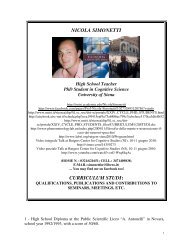
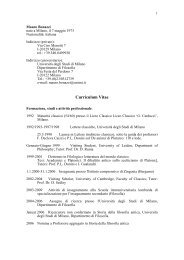
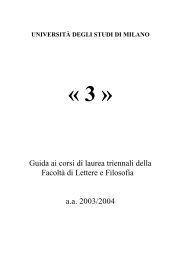
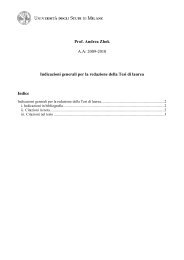
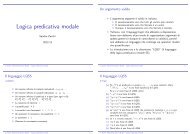

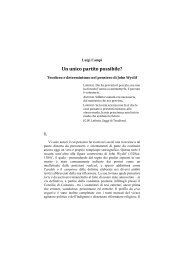
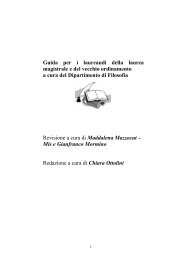
![La teoria dei condizionali [0.2in] di Stalnaker - Dipartimento di Filosofia](https://img.yumpu.com/43208857/1/190x135/la-teoria-dei-condizionali-02in-di-stalnaker-dipartimento-di-filosofia.jpg?quality=85)
